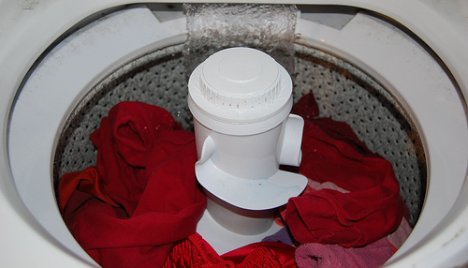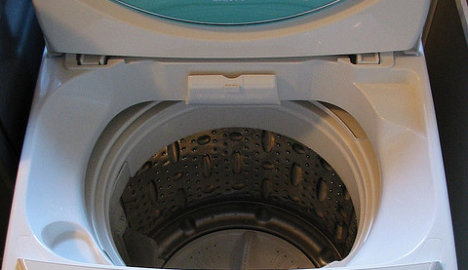A full 90 percent of the energy used in washing clothes goes toward heating the water, so it stands to reason that using less energy by washing in cold, unheated water would create significant environmental savings. But just how much difference are we really talking about?
 We got the TreeHugger HQ math monkeys to crunch some numbers, and came up with some pretty interesting results. It turns out that pressing the cold/cold button (instead of the hot/warm button) on your washing machine has the same impact as…
We got the TreeHugger HQ math monkeys to crunch some numbers, and came up with some pretty interesting results. It turns out that pressing the cold/cold button (instead of the hot/warm button) on your washing machine has the same impact as…
…driving about 9 miles in a car or the production, transportation and storage of a six pack of beer. It may not be too surprising that one load of laundry doesn’t make a huge amount of difference compared to, say, not eating meat or dairy. But, multiply those impacts by 392 — the number of laundry loads an average U.S. home washes in a year — and, all of the sudden, there are some real impacts.
Washing laundry in hot water is really wasteful
To wit: Washing every load on the hot/warm cycle (in a top loading machine and an electric water heater) for a year is equivalent to burning about 182 gallons of gasoline in a car; in an average (19.8 miles per gallon) car, that’ll get you around 3595 miles. So, wash in hot/warm, or drive almost 3600 miles — same difference.
Similarly, if you wash with the hot/cold cycle (in a top loading machine and an electric water heater), you’ll end up with 2407 pounds of CO2 per year — just over a metric ton — which is equal to about one round-trip cross-country flight (6171 miles of long-haul flying).
Using a gas water heater is far more efficient
If you’ve got a gas water heater, the news is a little greener. You’re looking at 3.22 pounds of CO2 per load, which translates to just over 3 miles in a car; add that up over an average year’s worth of washing, and you’re looking at just over 1288 miles in a car or about 1262 pounds of CO2, or most of the way from New York City to London by airplane.
Using cold water can really net you some savings
When you use cold water to wash, you just use energy to run the machine — about .24 kWh — without using any energy to heat the water. That .24 kWh translates to about .41 pounds of CO2 per load, or about 162 pounds of CO2 per year. That’s about 8 gallons of gas, or 164 miles of driving. Compare that to the 3595 miles of driving that the top end of the emissions scale (washing in hot/warm, using a top-loading machine and water heated with an electric water heater), and pressing that cold/cold button starts to make a sizable difference.
Using an efficient Energy Star machine makes a big difference, too
Energy Star estimates that water savings range from 40 percent to 75 percent with front-loading washing machines, so their relative impact would be comparably less.
What does this all mean? Aside from being a great example of how little decisions add up to make a big difference, it shows how wasteful heating large quantities of water can be. Just selecting the “cold/cold” cycle has the potential to save as much CO2 emissions each year as thousands of miles driven in a car, or even an airplane flight or two.
Source: http://www.treehugger.com/
Dear User/Visitor! Please, answer on our questions: tick off one of the positions – your answer will make us able to improve our site and make it more interesting and useful!


